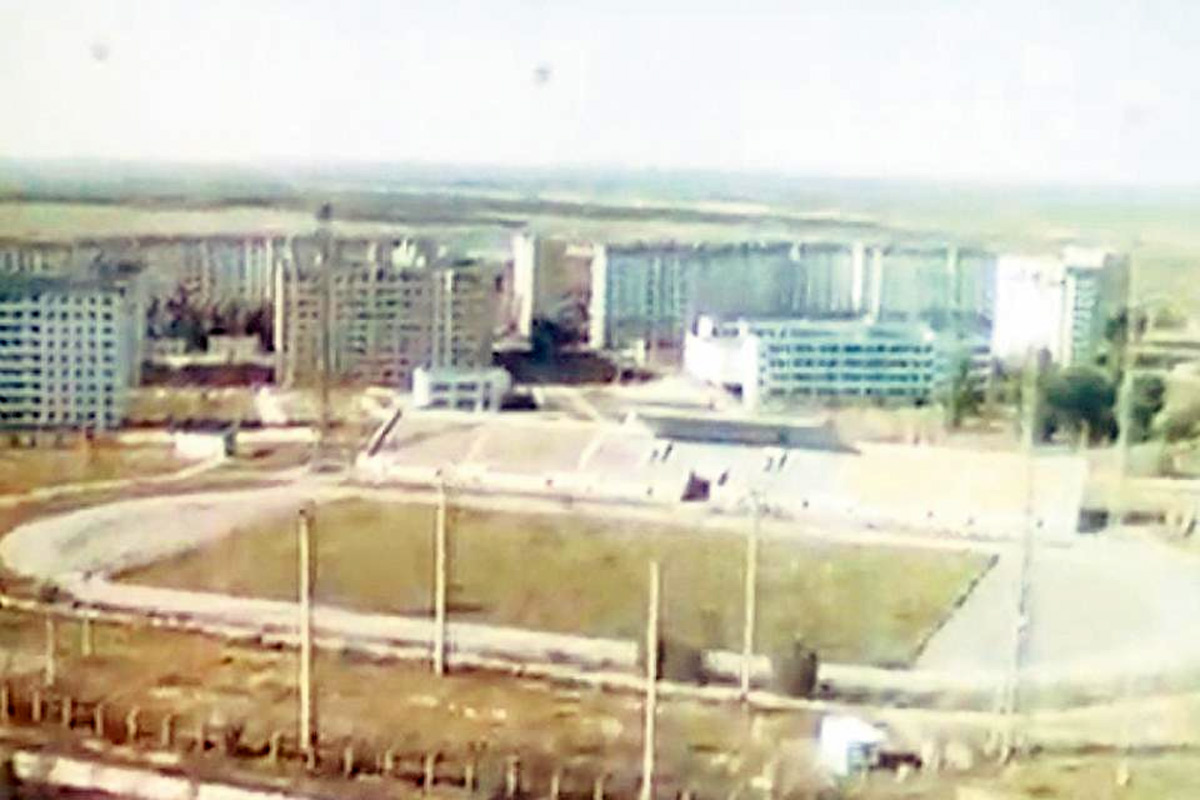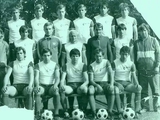Your attention is drawn to the material of the Italian edition Il Nobile Calcio, timed to the recent anniversary of the Chernobyl disaster.
 Team «Builder» (Pripyat)
Team «Builder» (Pripyat)On Saturday morning, 26 April 1986, a helicopter landed on a football field in northern Ukraine. The Pripyat players were preparing for the Cup semi-final against Borodyanka, which was to take place later in the afternoon.
They saw people in protective suits and with radiation detectors coming out of the helicopter. When the detectors went off with an audible warning, the men informed the players that the match would not be played. There was an accident at a neighbouring nuclear power plant, also known as Chernobyl.
Pripyat was a suburban town located a couple of miles from the nuclear power plant and about ten miles from the city of Chernobyl. Founded in 1970, it was a modern, progressive "nuclear town" meant to represent the best of the Soviet Union, a now-defunct state that included 15 republics.
Pripyat had a cinema, a swimming pool, an amusement park and several palaces. About 50,000 people lived in the city. There was also a football team called "Stroitel" (Pripyat) (hereafter referred to as "Pripyat" - ed.).
"Stroitel" means builder. The team was made up of men who worked on the construction of the Chernobyl nuclear power plant and the city of Pripyat, with the support of Vasily Kizima, the head of construction. Sport played an important role in Soviet society and was incorporated by the state into the daily lives of its citizens. "I have people working four shifts and they have nowhere to go to rest," Kizima said, "let them go and watch football and drink beer.
Pripyat's modest stadium was located in the shadow of residential neighbourhoods. The field was surrounded by athletics tracks, a structure used as a changing room, and a small grandstand with wooden benches. It was often full of spectators, even though the club was in the fifth amateur division of the Soviet football league. "Everyone in Pripyat loves football," said footballer Alexander Vishnevsky. - Two thousand of them come to watch us."
In the distance, beyond the border fence, the smokestack of the Chernobyl reactor 500 feet high could be seen...
Chernobyl opened in 1977, and Pripyat became a working town as a result. The youngest player on the team, Valentin Litvin, did not yet work at the plant, as he was still in school. Litvin was one of six brothers, all decent players, and was born in the neighbouring village of Chistogalovka. He studied in Pripyat.
"I remember an episode from sixth grade," Litvin says in a conversation with Valery Shkurdalov of Discover Chernobyl. - I was taking an algebra exam and had to play. Our teacher looked out the window and said: "Who are they waiting for?" There was a bus and there was a team waiting for me, all grown men."
In 1978, after graduating from high school, Litvin began working as an engineer in Chernobyl. Like most Pripyat players, in addition to his salary at the power plant, he received a small allowance for playing football - 2 roubles 50 kopecks for district matches and 5 roubles for regional matches. But some of his teammates were players brought in from all over the region specifically to play football.
"They were called 'snowdrops,'" Litvin says. - They were named that because, like flowers, they appeared at the end of winter. They received a salary from the power plant and were listed on the payroll, but they didn't do any work."
With the support of a powerful team and with "sub-snowmen" in their ranks, "Pripyat" fought to move to the fourth professional level. In 1981, they appointed former USSR striker Anatoly Shepel, a national champion and Cup winner with Dynamo Kyiv, as coach. "That was the moment when our team started to take shape," says Litvin, who became captain at the time.
"Pripyat," sporting white T-shirts and blue shorts, won the regional Cup in 1981, 1982 and 1983, struggled in the championship but remained in the fifth division.
In 1986 the club built a new Vanguard Stadium with better facilities, lighting and a large covered grandstand. It had a capacity of 11,000 spectators. At the time, authorities were planning to build a fifth reactor at Chernobyl. "The stadium is as important for the city as the reactor," Vasily Kizima said.

The field was to be officially opened on 1 May 1986, but before that Pripyat were due to play a cup semi-final against Borodyanka on 26 April.
At 1:23 that morning, Chernobyl's nuclear reactor No. 4 exploded. People in Pripyat saw a flash and heard an explosion. Raging flames were visible in the darkness and firefighters were dispatched to the scene.
This was not the first accident at Chernobyl (a partial core meltdown had occurred in 1982) and it was thought to be over soon. Local residents stood outside and watched the fire as ash fell from the sky. After dawn, when the fire had died down, they continued their lives. They shopped, prepared for the May Day parade and headed to the football field for the big match.
Valentin Litvin spent the night with his family in Yampol, a few kilometres away. His wife was hospitalised in Pripyat due to complications from the birth of their second child, and the child was cared for by the family. He returned to Pripyat at 9am and was stopped by police at the entrance to the city. "I asked them what happened, but they didn't know anything," he says. - In the end, I went to the stadium."
The sun was shining, and Litvin recalls seeing people walking with children. A street vendor was selling vegetables. All of them were unaware that Chernobyl had been the site of the worst accident in the history of nuclear power. The only real sign that something was wrong was the sight of vehicles moving slowly away from the plant and spraying the streets with disinfectant. Pripyat will not be evacuated for another 36 hours.
At the stadium, Litvin met with other players and coaches who told him that Borodyanka's team had been stopped well outside Chernobyl. So Litvin travelled to the team's headquarters, located in a nine-story building, to see if the game would take place. Shortly after his arrival, one of the coaches introduced himself to Litvin and told him about the helicopter landing on the field. He went up to the roof. "I could see the nuclear power plant," he says, "and smoke rising above the ruins of the No. 4 reactor.
Litvin's thoughts turned from football to his wife. He rushed her to the hospital, where she told him what had happened last night. "Of course, she didn't see everything," he explains. - There was noise, commotion, doctors were running around the building looking for missing infusion sets, and victims were arriving one by one."
His wife could not be discharged, so they had to organise an "escape". Litvin helped her escape out of a ground floor window. "We saw hospital patients standing on a hill from where they had a clear view of the plant and could see helicopters dropping some materials into the destroyed reactor."
The couple left Pripyat on motorbikes, bypassing long queues of empty buses. "They were waiting for the command to enter the city and start the evacuation," Litvin says. - Radiation background levels were already very high. The buses didn't arrive until noon the next day, 27 April."
The Soviet Union tried to keep the Chernobyl accident a secret even from its own citizens. "The information, in addition to being unavailable, was simply unbelievable," Litvin continues. - "I, like many others, believed that the reactor simply could not explode.
The outside world finally learned of the accident on 28 April, when high levels of radiation were detected 800 miles from Sweden.
The Chernobyl disaster released at least 400 times more radioactive material than the Hiroshima bomb. A 19-mile exclusion zone was created around the plant, and Pripyat residents were never allowed to return to their homes, with many moving some 30 miles away to the town of Slavutich. Several Pripyat players founded a new club there, Stroitel (Slavutich). Valentin Litvin ended up in Obukhov and started playing for Zarya from Vladislavka.
Another evacuated player was the future Milan and Chelsea striker Andriy Shevchenko, then a nine-year-old player of the children's team of Dynamo Kyiv. Kiev was the nearest major city to Chernobyl, so Shevchenko and the rest of the boys were taken 250 miles south to a children's camp on the Black Sea coast.
Despite everything, the football continued. On 2 May, less than a week after the injury, Dynamo Kyiv faced Atletico in the Cup Winners' Cup final in Lyon. "As for the Chernobyl events," Dynamo coach Valeriy Lobanovskiy told the press, "my players knew about it, but were not worried in preparation for the match." "Dynamo" with Soviet stars Oleg Blokhin, Vasily Rats and Igor Belanov defeated Atletico 3-0.
There was a lot of important work to be done in Chernobyl. Both Alexander Vishnevsky and Valentin Litvin acted as "liquidators" during the recovery and clean-up operation. Litvin helped to decontaminate the basements of the power plant, where the high level of radiation allowed only a few minutes to stay, and deadly pieces of graphite from the exploded reactor core were dropped from the roof above.
Liquidators had radiation charts and dosimeters to limit their exposure, but Litwin says they often had to push the safety limits to do their jobs. Some 600,000 men and women were involved in the cleanup, this dangerous work for the brave that ultimately saved much of Europe from becoming uninhabitable.
One of the liquidators, helicopter pilot Eduard Korotkov, recalled flying over the damaged reactor for two hours every day that summer and then watching football on TV at night. "There was a World Cup going on," he recounted in his book Prayer for Chernobyl, "so we talked a lot about football."
The USSR team in Mexico included the Dynamo Kiev triumvirate of Blokhin, Rats and Belanov, and was led by Dynamo coach Lobanovsky, who sought to downplay the significance of an event that remained shrouded in Soviet secrecy. "I think our government provided journalists with all the facts about what really happened after a campaign launched by the international press," he said. After beating Hungary 6-0 and winning their group, the Soviet team lost 3-4 to Belgium in extra time in the 1/8 finals despite Belanov's hat-trick.
"Stroitel" (Slavutich), the successor of "Stroitel" (Pripyat), did not last long. The new team played in the amateur championship in 1987 and 1988, but then disintegrated.
Players and fans were scattered throughout the region, and many were concerned about the liquidation of Chernobyl. Large numbers of residents of Pripyat and the exclusion zone became ill and died.
Today, the Avangard Stadium, never used in Pripyat, is an unusual tourist attraction; rusted and overgrown floodlights inside a radioactive ghost town that nature is rebuilding. Valery Shkurdalov runs the "Discover Chernobyl" Facebook page and works as a guide in Pripyat and the exclusion zone.
"The stadium is often visited by tourists," he says, "although the field is covered with trees. One of the visitors Shkurdalov brought to the exclusion zone was Valentin Litvin, now retired but still playing football and refereeing locally. It was his first time back in Pripyat.
The Chernobyl clean-up project is expected to end in 2065 and experts believe the exclusion zone will remain contaminated for another three thousand years. No one will be playing football in Pripyat anytime soon. Meanwhile, in Ukraine, war with Russia has broken out.
Mario Bocchio, Il Nobile Calcio











